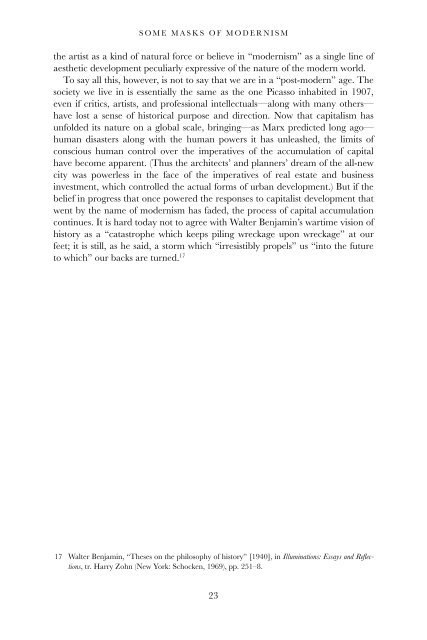Art in its Time: Theories and Practices of Modern Aesthetics
Art in its Time: Theories and Practices of Modern Aesthetics
Art in its Time: Theories and Practices of Modern Aesthetics
You also want an ePaper? Increase the reach of your titles
YUMPU automatically turns print PDFs into web optimized ePapers that Google loves.
SOME MASKS OF MODERNISM<br />
the artist as a k<strong>in</strong>d <strong>of</strong> natural force or believe <strong>in</strong> “modernism” as a s<strong>in</strong>gle l<strong>in</strong>e <strong>of</strong><br />
aesthetic development peculiarly expressive <strong>of</strong> the nature <strong>of</strong> the modern world.<br />
To say all this, however, is not to say that we are <strong>in</strong> a “post-modern” age. The<br />
society we live <strong>in</strong> is essentially the same as the one Picasso <strong>in</strong>habited <strong>in</strong> 1907,<br />
even if critics, artists, <strong>and</strong> pr<strong>of</strong>essional <strong>in</strong>tellectuals—along with many others—<br />
have lost a sense <strong>of</strong> historical purpose <strong>and</strong> direction. Now that capitalism has<br />
unfolded <strong>its</strong> nature on a global scale, br<strong>in</strong>g<strong>in</strong>g—as Marx predicted long ago—<br />
human disasters along with the human powers it has unleashed, the lim<strong>its</strong> <strong>of</strong><br />
conscious human control over the imperatives <strong>of</strong> the accumulation <strong>of</strong> capital<br />
have become apparent. (Thus the architects’ <strong>and</strong> planners’ dream <strong>of</strong> the all-new<br />
city was powerless <strong>in</strong> the face <strong>of</strong> the imperatives <strong>of</strong> real estate <strong>and</strong> bus<strong>in</strong>ess<br />
<strong>in</strong>vestment, which controlled the actual forms <strong>of</strong> urban development.) But if the<br />
belief <strong>in</strong> progress that once powered the responses to capitalist development that<br />
went by the name <strong>of</strong> modernism has faded, the process <strong>of</strong> capital accumulation<br />
cont<strong>in</strong>ues. It is hard today not to agree with Walter Benjam<strong>in</strong>’s wartime vision <strong>of</strong><br />
history as a “catastrophe which keeps pil<strong>in</strong>g wreckage upon wreckage” at our<br />
feet; it is still, as he said, a storm which “irresistibly propels” us “<strong>in</strong>to the future<br />
to which” our backs are turned. 17<br />
17 Walter Benjam<strong>in</strong>, “Theses on the philosophy <strong>of</strong> history” [1940], <strong>in</strong> Illum<strong>in</strong>ations: Essays <strong>and</strong> Reflections,<br />
tr. Harry Zohn (New York: Schocken, 1969), pp. 251–8.<br />
23
















